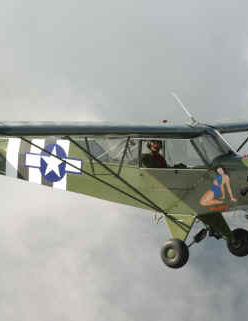

1942 Piper Cub
Fleet Model 8
The Story of
"Lulu Belle"
Her name is "Lulu Belle." She was built for the Army as a Piper L-4B (Army 43-1066) at the Piper factory in Lock Haven, PA. She was completed just before Christmas in 1942. The price... $2,130.
The Army affectionately referred to these small aircraft as L-Birds, or "Grasshoppers." They were used by all the armed forces in every theater of war. Flying Magazine called the Piper Cub, "one of the most consequential aircraft of all time."
This Cub was assigned to Camp Butner in North Carolina and used as a spotter for artillery training during WWII.

War time use
We don't have any pictures of the plane when she was stationed at Camp Butner. But the picture above shows how she would have looked during the war. The plane was overall Army green, and the cabin featured windows running part way down the back of the plane for observation purposes.

Camp Butner is just outside of the Raleigh-Durham area in North Carolina. During the war it was used to train infantry troops. Later it became a camp for WWII enemy soldiers.
A group of Piper L-4B Cubs were assigned to Butner. They provided training for artillery spotters. The pilot would sit in front and fly the plane. A spotter with field glasses and a radio sat in back. They had the advantage of flying over the battlefield and calling in reports. They directed the artillery toward the enemy positions.
It took a great deal of courage to fly a small, slow aircraft over the enemy. They were easily spotted and were subject to small arms fire from the ground. Nevertheless, the soldiers performed a valuable and brave service in helping to win the war.
Cubs were used on the battlefield because they could be flown to forward areas quickly and easily. They often did not even need a runway, instead landing in fields or on roads. As the American Army marched across Europe after the invasion, the Cubs went ahead of the soldiers, doing reconnaissance, spotting for artillery, directing tanks and personnel, providing transportation, and evacuating the wounded.
Generals Eisenhower and Patton often used L-4 Piper Cubs to get around the battlefield and see for themselves the condition of their Army and enemy.

Above:
An L-4 Cub operating from a road.
Right:
General Dwight Eisenhower in the back seat about to takeoff in an L-4 Cub over the battlefield.

Post war use
After the war this Cub was sold as surplus for $776 and converted to a J-3. The conversion work included changing the back window configuration and painting the airplane Cub Yellow. After going through a series of owners in NC and GA, the plane was acquired in 2005 and now resides in Hangar Three with the Historic Aircraft Preservation Society.
The plane went through another major renovation in 2002.
Because most of her life has been spent in the south, a true Southern name has graced the plane since 2005... "Lulu Belle".
today
"Lulu Belle" is in excellent condition and is flown regularly. She is currently teaching several youth to fly. Starting with basic maneuvers in a taildragger is helping to sharpen their skills and make them better pilots throughout their career.
restoration plans
The Historic Aircraft Preservation Society has plans to bring "Lulu Belle" back to her original configuration as she was during WWII. This will include a return to Army colors, and the restoration of the "greenhouse" canopy that made spotting much easier.
Having fun...
Sometimes "Lulu Belle" just likes to go out and have fun. Check out these two kids who are enjoying the ride. Both are now older and learning to fly the Cub from the front seat.










